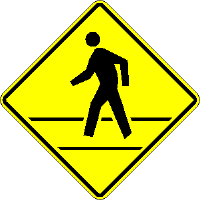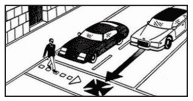 This morning, standing in a crosswalk, I stood 15 feet from a tractor trailer as it barreled through a red light.
This morning, standing in a crosswalk, I stood 15 feet from a tractor trailer as it barreled through a red light.
This afternoon, I found this article about plain-clothed cops busting drivers that fail to yield to pedestrians.
These got me thinking: what are a pedestrian’s rights and responsibilities? What are the actual rules (not just what I wanted to shout at the truck driver)? Let’s take a gander at the definitive source for California’s rules of the road, the California Vehicle Code.
California Vehicle Code
Chapter 5. Pedestrians’ Rights and Duties
California’s vehicle code requires that “safe and convenient pedestrian travel and access, whether by foot, wheelchair, walker, or stroller, be provided to the residents of the state”. As they teach you in pedestrian-advocate school, what’s great for a wheelchair also makes life better for an able-bodies pedestrian.
The driver of a vehicle shall yield the right-of-way to a pedestrian crossing the roadway within any marked crosswalk or within any unmarked crosswalk at an intersection.
 What’s an unmarked crosswalk you ask? Let’s say you’re walking down the sidewalk, and the street comes to an intersection. The ten-foot wide piece of road that extends from the sidewalk you’re standing on across the road and to the other side is a legal crosswalk. If the crosswalk is painted, it’s a “marked crosswalk.” If there’s a traffic signal or stop sign, it’s a “controlled intersection.” But whatever the paint or signage, it’s a legal crosswalk, and vehicles are required to yield to pedestrians.
What’s an unmarked crosswalk you ask? Let’s say you’re walking down the sidewalk, and the street comes to an intersection. The ten-foot wide piece of road that extends from the sidewalk you’re standing on across the road and to the other side is a legal crosswalk. If the crosswalk is painted, it’s a “marked crosswalk.” If there’s a traffic signal or stop sign, it’s a “controlled intersection.” But whatever the paint or signage, it’s a legal crosswalk, and vehicles are required to yield to pedestrians.
A study by the Berkeley Traffic Safety Center found that 35 percent of drivers surveyed did not believe pedestrians have the right-of-way at marked crosswalks. Just because the law if on your side, look both ways.
(Photo from Atlanta-based Peds.Org)
But if you’re crossing away from a legal crosswalk, yield to drivers, because that’s where they have the right-of-way. Unless there’s street construction or the crosswalk is out of service, in which case pedestrians should walk along the roadway to the left-side, and be careful.
 Whenever any vehicle has stopped at a crosswalk to permit a pedestrian to cross the roadway the driver of any other vehicle approaching from the rear shall not overtake and pass the stopped vehicle.
Whenever any vehicle has stopped at a crosswalk to permit a pedestrian to cross the roadway the driver of any other vehicle approaching from the rear shall not overtake and pass the stopped vehicle.
If you see a car stopped for a pedestrian in a sidewalk, you’re legally obligated to also stop. The pedestrian is less likely to see a second car coming behind a stopped car.
A totally or partially blind pedestrian carrying a predominantly white cane (with or without a red tip), or using a guide dog, the pedestrian has the right-of-way. There are steep fines for using white canes in this way if you aren’t actually blind.
Also, no person may stop a vehicle unnecessarily in a manner that causes the vehicle to block a marked or unmarked crosswalk or sidewalk. Don’t block the sidewalk, either – leave enough room for a person in a wheelchair to comfortably pass.
Be safe out there!
